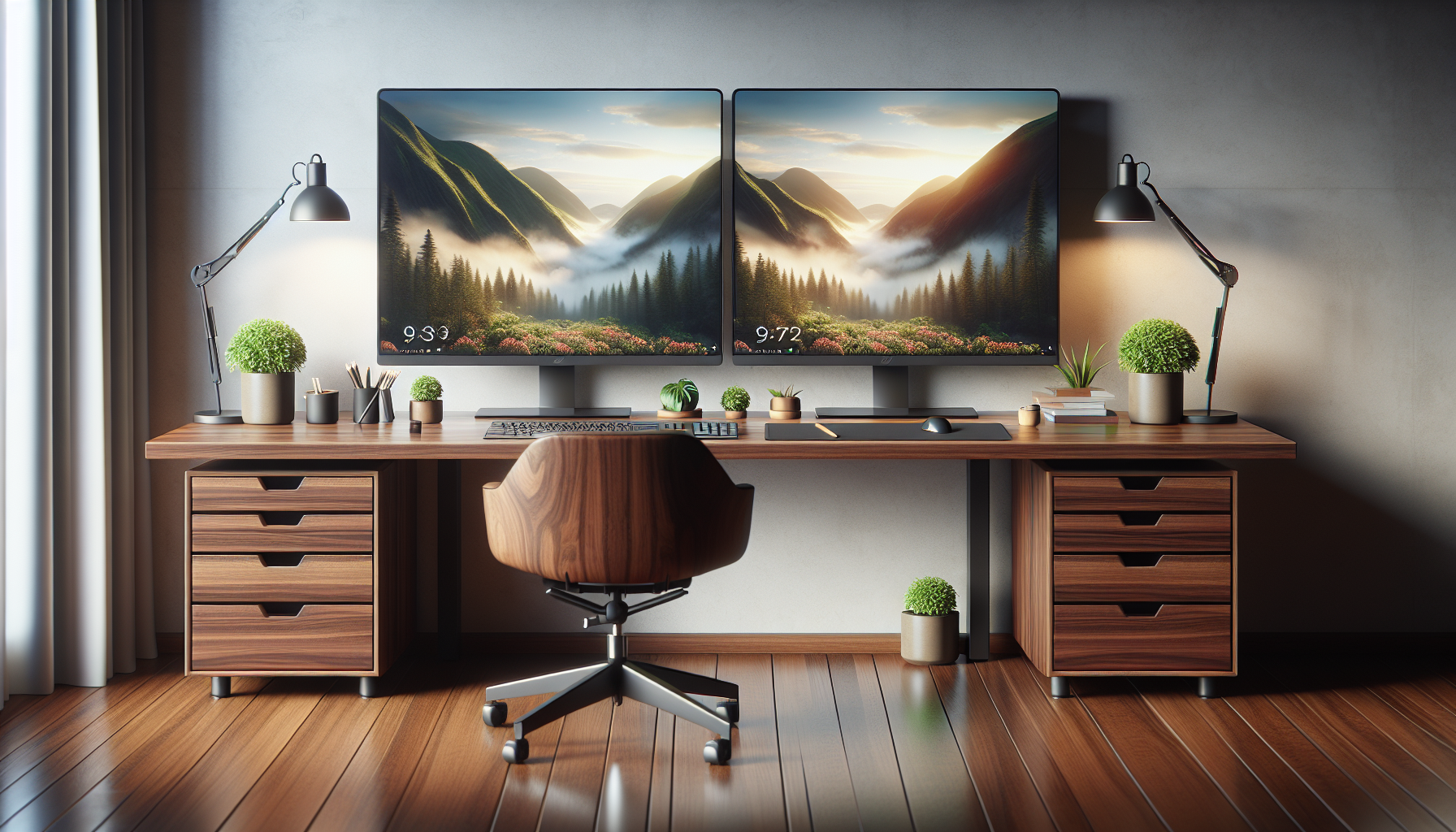Your cart is currently empty!

The Ultimate Guide to Dual Monitor Desk Layouts
Understanding Dual Monitor Desk Layouts
Dual monitor desk setups have become increasingly popular among professionals, gamers, and multitaskers alike. The ability to expand digital workspace enhances productivity, provides an immersive experience, and enables efficient task management. Optimizing your desk layout to accommodate two screens can transform how you work and play.
Benefits of Dual Monitor Setups
Employing dual monitors can significantly improve workflow. Studies show a 20-30% increase in productivity when using two screens. This setup allows for seamless multitasking, providing easy access to multiple applications or documents simultaneously. For gamers, dual monitors expand the field of view, delivering a more engaging experience.
Essential Considerations
Before setting up a dual monitor desk layout, consider the following:
-
Space Availability: Ensure your desk provides enough space for two monitors. Measure the desk and compare it with the size of your monitors.
-
Purpose and Use: Define the primary purpose of your setup. Workstations for coding, gaming, and content creation may require different configurations.
-
Monitor Compatibility: Check if your monitors have the same resolution and refresh rate. Discrepancies can affect visual consistency and performance.
-
Ergonomics: Prioritize comfort. Adjust your monitors so they’re at eye level and maintain a neutral posture to prevent strain.
Choosing the Right Monitors
Choose your monitors wisely to maximize the benefit of a dual monitor setup. Consider these factors:
- Screen Size and Resolution: Larger screens with higher resolutions offer better clarity and a more immersive experience.
- Panel Type: IPS panels provide better color accuracy and viewing angles, ideal for designers, while VA panels offer superior contrast, making them suitable for gamers.
- Refresh Rate: A minimum of 60Hz is recommended for smooth visuals, but gamers might prefer 144Hz or more for fluid motion.
Desk Layout Options
Once you’ve selected the appropriate monitors, consider these popular desk layouts:
-
Side-by-Side Layout:
- Pros: Simplified cable management, easier task switching.
- Cons: Larger desk space required.
- Ideal for: Office setups, general multitasking.
-
Stacked/Vertical Layout:
- Pros: Saves horizontal space.
- Cons: May require a monitor stand or arm, potentially awkward viewing angles.
- Ideal for: Limited desk space, programming.
-
L-Shape Arrangement:
- Pros: Utilizes corner space effectively, offers distinct zones for different tasks.
- Cons: Can be complex for cable management.
- Ideal for: Gaming and streaming.
-
Freestanding Mounts:
- Pros: Maximize adjustability and flexibility in positioning.
- Cons: May require additional investment.
- Ideal for: Dynamic workspaces requiring frequent adjustments.
Ergonomic Setup Tips
Implement the ergonomic best practices to enhance comfort and reduce physical strain:
- Eye Level: The top of the screen should align with your eyes when seated.
- Distance: Position monitors about an arm’s length away to prevent eye strain.
- Angle: Slightly tilt monitors backward (about 10-20 degrees) for optimal viewing.
- Chair and Desk: A good chair and adjustable desk can prevent long-term health issues.
Cable Management Strategies
A clutter-free environment contributes to productivity. Effective cable management strategies include:
- Cable Trays and Raceways: Hide cables under the desk to keep them out of sight.
- Cable Ties and Clips: Secure loose cables and keep them organized.
- Docking Stations: Reduce cable clutter by centralizing device connections.
Additional Accessories
Enhance your dual monitor setup with these accessories:
- Monitor Arms: Increase versatility and ergonomic positioning.
- Keyboard and Mouse: Consider ergonomic designs for prolonged use.
- Lighting: Prevent eye strain with adjustable desk lamps or LED strips.
- Desk Organizers: Keep your workspace tidy and efficient.
Technical Tips for Optimal Performance
Ensure your dual monitor setup runs smoothly with these technical adjustments:
- Graphics Card Support: Ensure your computer’s graphics card supports dual monitors without performance drops.
- Display Settings: Adjust resolution and scaling for consistency across screens.
- Software Solutions: Use programs like DisplayFusion or Actual Multiple Monitors to customize your setup.
Regular Maintenance and Upkeep
Regularly maintain your setup to ensure longevity and performance:
- Cleaning: Dust screens and surfaces with microfiber cloths.
- Hardware Checks: Regularly inspect monitor mounts and cables.
- Update Drivers: Keep graphics drivers updated to prevent lag and improve compatibility.
By considering these elements and carefully planning your dual monitor desk layout, you can reap the benefits of increased productivity, comfort, and enjoyment. Tailor your setup to your specific needs and continuously adjust for the best experience.
by
Tags:
Leave a Reply